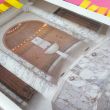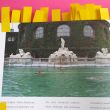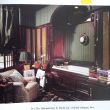In 1993, Diane Von Furstenberg published The Bath, a book on the history of bathing, with poetic observations on the relationship between humankind and water accompanied by photos of the bathrooms of her fabulous friends, leading one to believe that DVF chooses her pals based on whether or not they have a sunken marble tub for her to use when she visits their country home—amazing. Some excerpts:
- “The bath is the cradle for communion with life, because water is the source of all that lives. Through the ritual of bathing we worship water.” After all, a wise man once said, “wetness is the essence of beauty.”
-“Showers are popular for their speed and efficiency, but baths remain the rite passed down from our ancestors, who understood the need for hygiene and pleasure.” Let's not forget that our ancestors also lacked the plumbing expertise and wherewithal to even have showers...but yes, agreed.
-On the formation of life on Earth: “From the Garden of Eden, bountiful waters issued forth, flowing out from the center of Paradise to give birth to all of life in its many forms. Coursing across the crust of the earth, these waters formed a brilliant blue web, filling vast seas and delicate ponds, frothing rivers and spectacular waterfalls. Here, a unique environment was created: quiet, protective…the ideal setting for the first living organism to take form.”
-“Caligula is said to have gratified his whims by swallowing pearls dissolved in aromatic vinegar while soaking in scented oils, and Heliogabalus allegedly took on the task of bathing with all the prostitutes of Rome.” Some also say that the lead used in the city's infrastructure—specifically the plumping system—caused rampant mental illness and eventually contributed to the fall of the Roman Empire. Oh, that Caligula!
-On the baths at Caracalla, Rome: “The citizens, dwarfed by majestic columns, could move through the facility’s network of corridors, passing in and out of galleries, lecture halls, massage rooms, and shops for as long as they desired.”
-On how our ancestors did the whole dry-shampoo-and-baby-wipes thing, too: “The plagues and other widespread diseases of the Middle Ages had inspired a growing belief that water itself was a carrier of infections. Most people went to great lengths to avoid water, having been warned that exposure to it would open the pores and weaken the constitution. Bathing thus became a matter more of etiquette than of hygiene, the object being to maintain the appearance of cleanliness by keeping clean what was visible to others. Hands and face were washed, and clothing was frequently changed: King Louis XIV is said to have had innumerable clean white linen shirts at the ready for his frequent daily changes. But with respect to the rest of the body, 'cleaning' mostly meant masking odors.”
-On the odeur de Versailles: “As was typical of this era, the Palace of Versailles was erected entirely without plumbing. Though six bathrooms were installed during his reign, Louis XIV is said to have bathed only twice in his life and to have taken terribly ill after each occasion.”
-“Benjamin Franklin brought the first bathtub to the United States in the 1780s. He is said to have passed many hours in the tub writing as he soaked.” And ruined dozens of laptops in the process.
-On women needing “me' time in Turkish hummums: “The sexes were strictly segregated: a man entering the women’s quarters could be sentenced to death.”
-“At Aix-les-Bains, Napoleon’s sister Pauline lost a fortune at the casino (Napoleon had authorized gambling at bath resorts in 1806)…” You know what they say, “What happens at Aix-les-Bains stays at Aix-les-Bains.”
-“The centerpiece of Finland’s long bathing tradition is the sauna, some two thousand years old. Here is where folk-medicinal healing treatments were administered, where women bore their children and nursed them in the early weeks, and where the dead were prepared for burial.” Actually pretty neat.
-On how Arkansas was once the chicest American getaway locale: “Native Americans and pioneers set aside their conflicts to share the waters of Hot Springs, Arkansas, one of the great spas of the United States . . . Once Thomas Jefferson became aware of this natural wonder, the springs were given special attention and in 1832 became the first national reserve in the United States.”
-“In the late nineteenth century, La Paiva, the infamous marquise who brought both glamour and scandal to Paris society, also brought exoticism to the Parisian bathroom. With onyx- and ceramic-lined walls, turquoise faucets, and a third spout that some think ran champagne, she transformed a room in her home on the Champs Elysées into an opulent Moorish-style bath.” Similarly, there's a bar in Williamsburg that has Prosecco on tap.






















































